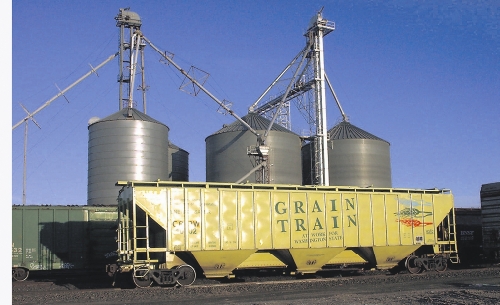forum
library
tutorial
contact

Can Trains Save Salmon?
by Bill MoyerSpokesman-Review, October 29, 2022
|
the film forum library tutorial contact |

|
Can Trains Save Salmon?by Bill MoyerSpokesman-Review, October 29, 2022 |
A set of relatively minor improvements would set the stage.
 This summer, Sen. Patty Murray and Gov. Jay Inslee published a report on dam breaching at the Lower Snake River to save salmon and other species. Their report indicated that they would strive to make dam breaching viable by replacing the services the dams provide and leverage the Infrastructure Investment and Jobs Act and the Inflation Reduction Act to do that.
This summer, Sen. Patty Murray and Gov. Jay Inslee published a report on dam breaching at the Lower Snake River to save salmon and other species. Their report indicated that they would strive to make dam breaching viable by replacing the services the dams provide and leverage the Infrastructure Investment and Jobs Act and the Inflation Reduction Act to do that.
Since then, we've heard a great deal from the governor about energy replacement, but next to nothing about transportation. This is puzzling since he seems to have a great deal more power to shape transportation than energy. His best opportunity to use that power to address barge transport service replacement is through his 2023-2025 transportation budget, due to the Legislature by mid-December.
Solutionary Rail is a project that advocates for policies and investments that make U.S. railroads better serve public and national interests. Last spring, we turned our focus to the Lower Snake River's grain transport and surrounding rail capacity, to determine whether trains can play a role in saving salmon.
We examined the current state of wheat transport by barges and trains. We assessed the current capacity at riverside ports and elevators and the history of rail service north and south of the river. We analyzed track capacity on the most important corridors. We examined the connectivity between the four short line railroads serving the area, their connections to Union Pacific and BNSF main lines, and their potential for reaching Columbia River barge facilities. We mapped a series of opportunities to repair and restore lines to improve local service, in order to reduce truck miles and the impacts and costs related to truck transport. We even did an energy analysis of rail routes to assess the potential for a new generation of powerful battery-electric locomotives to use regenerative braking in order to take advantage of the difference between empty trains going upslope and heavy trains coming downslope.
The 12-year annual average of 2.4 million tons of grain moved on LSR barges is the equivalent of approximately five additional 110-car trains per week. Our analysis determined that the current rail system has the capacity to endure the rapid, emergency pivot from barges to rail in order to prevent the extinction of Snake River salmon and steelhead. A set of relatively minor improvements would set the stage for that pivot. But, to truly address the economic and cultural needs of communities in Southeast Washington, those initial investments need to be part of a more comprehensive vision and plan for a truly sustainable and resilient rail transport system.
Solutionary Rail proposes a series of improvements to enhance rail capacity, connectivity, and competition for the long-term benefit to farmers, communities, and the environment in SE Washington. These improvements would reduce the impacts of trucks on public infrastructure, the environment, and the expense of shipping for farmers.
We address the vulnerabilities of a rail system dependent on BNSF and Union Pacific, both of which have abandoned Washington agricultural producers in the past with unilateral decisions to terminate the Cold Train and the Cold Connect train service. We recommend insulating short line railroads and farmers from the whims of these "class 1" railroads through investments that also connect short line railroads to Columbia River barges. More options mean more price competition and greater resilience across the system.
Washington state already owns much of the track on the Palouse, as well as excellent railbeds along and north of the Snake River. Repairing, expanding, and connecting those assets is an essential component of a sustainable LSR dam service replacement strategy. It is also an opportunity to breathe new life into struggling communities and local economies. Governor Inslee and the Legislature have the power to accomplish this, but they must begin the process in the coming session.
To help Gov. Inslee and the Legislature translate words into action, Solutionary Rail created a list of distinct transportation projects and draft language for a series of benefit-cost analysis (BCA) studies to fulfill federal prerequisites for accessing funding from the IIJA and IRA. These provide Governor Inslee with a set of realistic and unassailable line items for his 2023-2025 transportation budget.
Trains can save salmon, but only with decisive leadership from Governor Inslee, championing a vision for the future that is good for salmon, farmers, and communities in Southeastern Washington. We urge the governor to use his 2023-2025 transportation budget to provide that vision and chart that path. Solutionary Rail stands ready to help. (See SolutionaryRail.org/LSRbarge2rail)
Related Pages:
Users, Not Taxpayers, Should Pay for the Inland Waterways System by Jay Derr, Reason Foundation, 9/6/22
Related Sites:
LSR Barge to Rail Analysis and Proposal for Resilience by Solutionary Rail
learn more on topics covered in the film
see the video
read the script
learn the songs
discussion forum
